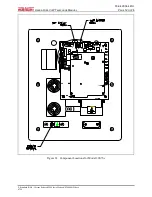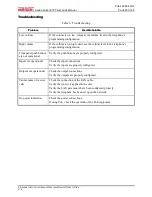
P
UB
.
42004-441H
H
ANDS
-
FREE
V
O
IP
T
ELEPHONE
M
ANUAL
P
AGE
18
OF
28
P:\Standard IOMs - Current Release\42004 Instr. Manuals\42004-441H.docx
07/16
Setup
Field Wiring
After all the field wires are pulled through the rear enclosure, install all connections as indicated below.
Refer to Figure 22 for wiring details. Refer to Table 5 on page 20 for the recommended conductor sizes.
N
OTE
:
Consult the National Electrical Code (NFPA 70), Canadian Standards Association (CSA 22.1),
and local codes for the specific requirements regarding your installation. Install all equipment without
modification and according to the local and national codes. Class 2 circuit wiring must be performed in
accordance with NEC 725.55.
Power
Power-Over-Ethernet (PoE)
Connect power to the system as indicated in your PoE equipment manual.
Local Power
When PoE is not available, a separate, isolated 24 to 48 V dc power supply is required. See the
“Replacement and Optional Parts” chart on page 28 for the recommended optional plug-in power supply
(required only if PoE is not available.) A removable terminal block P5 has been provided for connection
of local power to the telephone. Connect the positive conductor to the (+) terminal and the negative
conductor to the (−) terminal of P5. See Figure 22 for wiring and location of P5.
Table 2. Local Power Connection– P5
Pin
Label
Description
1
(+)
Positive
2
(−)
Negative
Ground
The enclosure must be connected to earth ground. Install a #6 ring lug on the ground conductor and
secure it with the ground terminal located on the rear of the front panel. See Figure 8 and Figure 14.
Network
Connect a category 5 or better cable with an RJ45 connector from the Local Area Network (LAN) to the
Ethernet jack located on the VoIP PCBA.












































